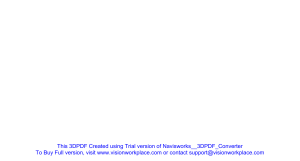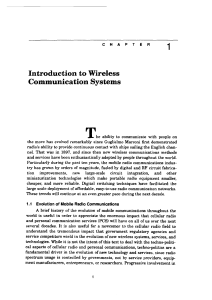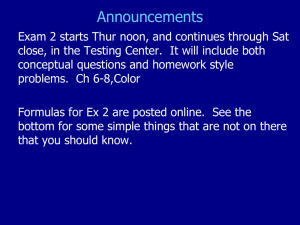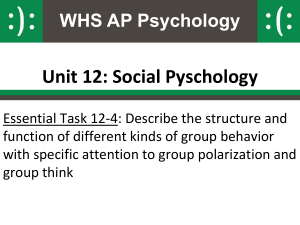A Broadband Linear to Circular Polarization Converter for 5G Millimeter Wave Communication
advertisement
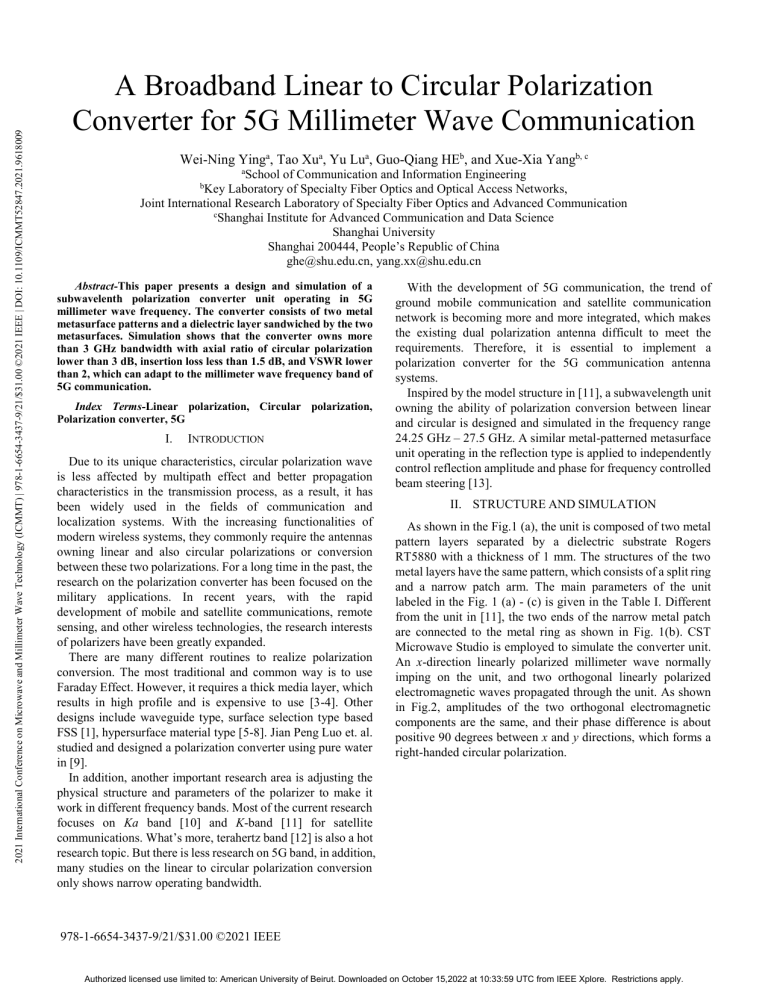
2021 International Conference on Microwave and Millimeter Wave Technology (ICMMT) | 978-1-6654-3437-9/21/$31.00 ©2021 IEEE | DOI: 10.1109/ICMMT52847.2021.9618009 A Broadband Linear to Circular Polarization Converter for 5G Millimeter Wave Communication Wei-Ning Yinga, Tao Xua, Yu Lua, Guo-Qiang HEb, and Xue-Xia Yangb, c a School of Communication and Information Engineering Key Laboratory of Specialty Fiber Optics and Optical Access Networks, Joint International Research Laboratory of Specialty Fiber Optics and Advanced Communication c Shanghai Institute for Advanced Communication and Data Science Shanghai University Shanghai 200444, People’s Republic of China ghe@shu.edu.cn, yang.xx@shu.edu.cn b Abstract-This paper presents a design and simulation of a subwavelenth polarization converter unit operating in 5G millimeter wave frequency. The converter consists of two metal metasurface patterns and a dielectric layer sandwiched by the two metasurfaces. Simulation shows that the converter owns more than 3 GHz bandwidth with axial ratio of circular polarization lower than 3 dB, insertion loss less than 1.5 dB, and VSWR lower than 2, which can adapt to the millimeter wave frequency band of 5G communication. Index Terms-Linear polarization, Circular polarization, Polarization converter, 5G I. INTRODUCTION Due to its unique characteristics, circular polarization wave is less affected by multipath effect and better propagation characteristics in the transmission process, as a result, it has been widely used in the fields of communication and localization systems. With the increasing functionalities of modern wireless systems, they commonly require the antennas owning linear and also circular polarizations or conversion between these two polarizations. For a long time in the past, the research on the polarization converter has been focused on the military applications. In recent years, with the rapid development of mobile and satellite communications, remote sensing, and other wireless technologies, the research interests of polarizers have been greatly expanded. There are many different routines to realize polarization conversion. The most traditional and common way is to use Faraday Effect. However, it requires a thick media layer, which results in high profile and is expensive to use [3-4]. Other designs include waveguide type, surface selection type based FSS [1], hypersurface material type [5-8]. Jian Peng Luo et. al. studied and designed a polarization converter using pure water in [9]. In addition, another important research area is adjusting the physical structure and parameters of the polarizer to make it work in different frequency bands. Most of the current research focuses on Ka band [10] and K-band [11] for satellite communications. What’s more, terahertz band [12] is also a hot research topic. But there is less research on 5G band, in addition, many studies on the linear to circular polarization conversion only shows narrow operating bandwidth. With the development of 5G communication, the trend of ground mobile communication and satellite communication network is becoming more and more integrated, which makes the existing dual polarization antenna difficult to meet the requirements. Therefore, it is essential to implement a polarization converter for the 5G communication antenna systems. Inspired by the model structure in [11], a subwavelength unit owning the ability of polarization conversion between linear and circular is designed and simulated in the frequency range 24.25 GHz – 27.5 GHz. A similar metal-patterned metasurface unit operating in the reflection type is applied to independently control reflection amplitude and phase for frequency controlled beam steering [13]. II. STRUCTURE AND SIMULATION As shown in the Fig.1 (a), the unit is composed of two metal pattern layers separated by a dielectric substrate Rogers RT5880 with a thickness of 1 mm. The structures of the two metal layers have the same pattern, which consists of a split ring and a narrow patch arm. The main parameters of the unit labeled in the Fig. 1 (a) - (c) is given in the Table I. Different from the unit in [11], the two ends of the narrow metal patch are connected to the metal ring as shown in Fig. 1(b). CST Microwave Studio is employed to simulate the converter unit. An x-direction linearly polarized millimeter wave normally imping on the unit, and two orthogonal linearly polarized electromagnetic waves propagated through the unit. As shown in Fig.2, amplitudes of the two orthogonal electromagnetic components are the same, and their phase difference is about positive 90 degrees between x and y directions, which forms a right-handed circular polarization. 978-1-6654-3437-9/21/$31.00 ©2021 IEEE Authorized licensed use limited to: American University of Beirut. Downloaded on October 15,2022 at 10:33:59 UTC from IEEE Xplore. Restrictions apply. Fig.1. Schematic diagram of the converter. (a) View from the z-axis; (b) metallic layer; (c) side view. In order to quantify the performance of this polarization conversion unit, the scattering parameters of linear polarized wave are converted into circular polarization scattering parameters by referring to the formula in [11]. The reflection coefficient in the frequency band is less than -10 dB, and the transmission coefficient is higher than -1.5 dB. The transmission coefficient and phase near the working frequency band are determined by Fig. 2. TABLE I PARAMETERS OF THE CONVERTER parameter length(mm) parameter length(mm) ri 1.235 d 0.95 rs 1.805 h 0.66 a 4.75 s 1.235 The axial ratio of the converted circular polarization wave is computed through the formula [11] AR g g 2 4 sin 2 / g g 2 4 sin 2 Fig. 2. Transmission coefficients in dB and phases of X and Y linearly polarized wave components of the converted RHCP wave. Last but not least, it is found that when the outer diameter of the metal layer increases or the opening decreases (that is, the length of the outer arc increases), the operating frequency will move to the lower frequency. When the outer diameter rs of the metal layer increases, the frequency with equal amplitude and phase difference of 90°in X and Y directions will change from a broad band, and then to a crossed point. And increasing the width of the patch follows the same rule. The operating frequency of the converter can be designed to fit specific applications by physically tuning its structural parameters. (1) where g and φ are determined by x x g TFP TFPy TFPy TFP TFPx TFPy . (2) (3) It is calculated that the internal axial ratio of the operating frequency band 24.25 GHz-27 GHz is less than 2 dB, and the 3 dB axial ratio bandwidth covers the frequency range 24.25-27.5 GHz, which meets the application requirements, as shown in Fig. 3. What is more, as shown in Fig. 4, the voltage standing wave ratio (VSWR) is between 1.05 and 1.25, less than 2, which also meets the requirements. Fig. 3. Axial ratio of the converted RHCP wave enabled by the proposed converter. Authorized licensed use limited to: American University of Beirut. Downloaded on October 15,2022 at 10:33:59 UTC from IEEE Xplore. Restrictions apply. Fig. 4. VSWR of the proposed linear to circular polarization converter. III. CONCLUSION In this paper, a polarization conversion unit working in the 5G millimeter wave band is proposed, which can realize the conversion from linear polarization to circular polarization in the 24.25 GHz-27.5 GHz band. Simulation implemented by using CST shows that the unit has low reflection loss, high transmission coefficient, low axial ratio and standing wave ratio in a broad bandwidth. At the same time, the unit structure only owns one dielectric layer and simple metal pattern, which is easy to fabrication and low cost. The working frequency can be adapted to the desirable band by designing the arc length of the metal layer. Microwave Workshop Series on Advanced Materials and Proc-esses for RF and THz Applications, 2016. [7] Xing Yang Yu, Xi Gao, Xu Han, Si Min Li, Wei Ping Cao, Xin Hua Yu, and Yan Nan Jiang, “High performance terahertz polarizati-on converter based on double V-shaped metasurface,” IEEE Internat-ional Conference on Communication Problem-Solving, 2015. [8] Jing Zhao, Yannan Jiang, and Congcong Shi, “Linear-to-circular polarization converter utilizing double-arc-based metasurface at terahertz frequency,” International Symposium on Antennas,Propagationand EM Theory, 2018. [9] Jianpeng Luo, Zibin Chi, Zhuowei Wang, Zhuozhu Chen, Zhenxin Hu, Xin Tian, and Duo-Long Wu, “A pure water linear-to-circular polarization converter,” International Workshop on Electromagnetics:Applications and Student Innovation Competition, 2019. [10] Parinaz Naseri, Sérgui A.Matos, Jorge R. Costa, Carlos A. Fernandes, and Nelson J. G.Fonseca, “Dual-band dual-linear-to-circular polarization converter in transmission mode application to K/Ka-band satellite communications,” IEEE Transactions on Antennas and Propagation, vol. 66, no. 12, pp. 7128-7137, Dec. 2018. [11] Parinaz Naseri, Rashid Mirzavand, and Pedram Mousavi, “Dual-band circularly polarized transmit-array unit-cell at X and K bands,” 10th European Conference on Antennas and Propagation, 2016. [12] Parinaz Naseri, and Pedram Mousavi, “K-band circularly-polarized reconfigurable transmit-array unit-cell,” IEEE International Symposiumon Antennas and Propagation & USNC/URSI National Radio Science Meeting, 2015. [13] Shengli Jia, Xiang Wan, Pei Su, Yongjiu Zhao, and Tiejun Cui, “Broadband metasurface for independent control of reflected amplitude and phase,” AIP Advances, vol. 6, no. 3, pp. 045024, 2016. ACKNOWLEDGMENT This work is supported by the National Natural Science Foundation of China (NSFC) under Grant No. 62001280, Shanghai Pujiang Program (20PJ1404300), 111 Project (D20031), and Guangxi Key Laboratory of Wireless Wideband Communication and Signal Processing. REFERENCES [1] Ting Zhang, Zewei Wu, Li Wang, Yuan Zheng, and Yelei Yao, “A high power polarization converter based on rectangular aperture frequency selective surface,” International Vacuum Electronics Confer-ence, 2017. [2] Yueting Zhang, Chibiao Ding, Bin Lei, and Weihai Fang, “A design of the complete polarization converter using dielectric periodic structures,” IEEE International Geoscience and Remote Sensing Symposium, 2018. [3] Xing Yang Yu, Xi Gao, Xu Han, Si Min Li, Wei Ping Cao, Xin Hua Yu, and Yan Nan Jiang, “High performance terahertz polarization converter based on double V-shaped metasurface,” IEEE Intern-ational Conference on Communication Problem-Solving, 2015. [4] Babar Kamal,Jingdong Chen, Yingzing Yin, Jian Ren, Sadiq Ullah, “A broad band polarization converting metasurface for C and X-band applications,” IEEE International Conference on Signal Proces-sing, Communications and Computing, 2020. [5] Congcong Shi, Yannan Jiang, and Jing Zhao, “Broadband terahertz linearto-circular polarization converter based on metasurface,” Inter-national Symposium on Antennas,Propagation and EM Theory,2018. [6] Yongjiu Li, and Long Li, “Reflective multi-functional polarization converter based on anisotropic metasurfaces,” IEEE MTT-S Internati-onal Authorized licensed use limited to: American University of Beirut. Downloaded on October 15,2022 at 10:33:59 UTC from IEEE Xplore. Restrictions apply.
